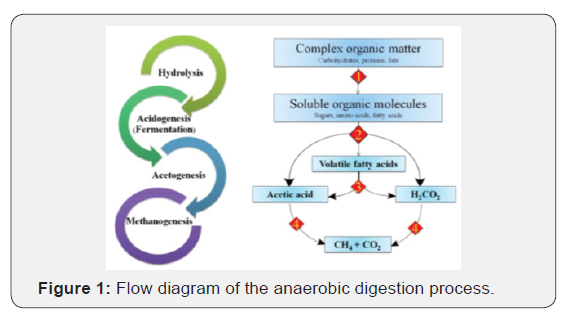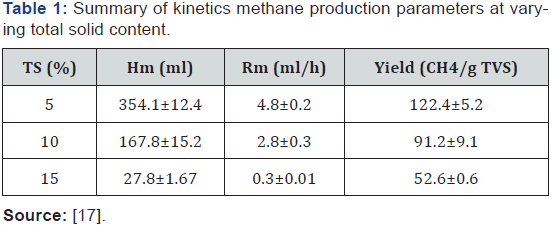Agricultural Research & Technology: Open Access Journal
Abstract
Because of the recent increase demand of energy,
interest in environmental issues and depletion of fossil fuel, the
demand of renewable energy sources as substitute of fossil fuel is
rapidly increasing. Production of biogas under anaerobic digestion as
methane can be used to replace nonrenewable energy resources in both
heat and power generation and as a vehicle. For biogas production
various organic feedstocks are used. Most often used are animal manure,
food waste, agricultural wastes and crop residues, aquatic waste, forest
residues, municipal solid wastes and grass. The review is based on
secondary data obtained through various sources such as textbooks,
journals, documents and conference papers with the objective of
providing an overview of biogas energy production from biomass, thus
providing information toward anaerobic digestion contributing to methane
rich biogas production. The review shows that biogas production from
biomass as a good fuel alternative because the source biomass can be
grown renewably and decrease environmental stress.
Keywords: Anaerobic digestion; Biogas; Methane; Feedstocks
Introduction
Energy is an essential factor in development since it
stimulates and supports a country’s economic growth and development
[1]. The global energy demand is growing rapidly, and about 88 % of this
demand is met at current time by fossil fuels. The depletion of fossil
fuel and the impact of greenhouse gases on the environment initiated the
concern in searching and exploring alternative sources of energy [2].
These sources are described as renewable energies such as solar energy,
wind energy, different thermal and hydro sources of energy, and biomass
[3]. Biomass residues available from agricultural and forest processing
constitute a potential source for biofuel production. Currently there
exist five forms of biofuels such as bioethanol, biodiesel, biomethanol,
biohydrogen and biogas [4].
The production of methane rich biogas (biomethane)
involves a complex biochemical reaction that takes place under anaerobic
conditions in the absence of oxygen and the presence of highly pH
sensitive microbiological catalysts that are mainly bacteria [5]. The
anaerobic digestion process is a fermentation process where organic raw
materials such as manure, food waste, and sewage sludge, organic
industrial waste and energy crops used as substrates for biogas
production. From energy crops the grass has the greatest potential for
biogas production (587.5m3 methane production/tone of dry organic
matter) [6]. The production of
biogas through anaerobic digestion offers several environmental
advantages compared to fossil fuels, because available and cheap
resources to feedstock, relatively easy and cheap technology for
production, extra values of digestate as a fertilizer [7], avoiding
health problems, reduce greenhouse gas (GHG) emissions , reduce
deforestation , reduce workload from women and children [8]. The
objective of this review is to provide an overview of biogas energy
production from biomass, thus providing information toward anaerobic
digestion contributing to methane rich biogas production.
Biogas Energy Production Under Anaerobic Digestion
Anaerobic digestion is a natural decomposition
processes in which microorganisms break down biodegradable material in
the absence of oxygen [3]. Anaerobic digestion is widely used as a
renewable energy source because the process produces a methane and
carbon dioxide rich biogas suitable for energy production, helping to
replace fossil fuels. The nutrient-rich digestate which is also produced
can be used as fertilizer. Fig .1 shows that the digestion process
begins with bacterial hydrolysis of the input materials in order to
break down insoluble organic polymers such as carbohydrates and make
them available for other bacteria. Acidogenic bacteria then convert the
sugars and amino acids into carbondioxide, hydrogen, ammonia, and
organic acids. Acetogenic bacteria then convert these resulting organic
acids into acetic acid,
along with additional ammonia, hydrogen, and carbon dioxide.
Finally, methanogens convert these products to methane and
carbon dioxide [9] (Figure 1).

Substrates for Biogas Energy Production
Biogas can be produced from biodegradable substrates such as
animal manure, food waste, agricultural wastes and crop residues,
aquatic waste, forest residues and municipal solid wastes [10].
According to [11] a brief description of the various feedstocks is
provided in this section.
Animal manure
Animal manure is considered a promising way for biogas
production and fertilizers through the anaerobic digestion process
[12]. There are significant populations of livestock in many
countries. Livestock produce large amounts of manure which
are suitable substrates for AD. Manure is a mixture of faeces and
urine, and its chemical composition varies markedly depending on
the chemical characteristics of the feed consumed by the animal.
Animal manure comprises huge amounts of lignocelluloses,
polysaccharides, proteins, and other biomaterials.
Municipal solid waste (MSW) and food waste
The food industry and municipal authorities produce a wide
range of lignocellulosic waste types. These include food waste and
municipal waste which can be used as substrates for biogas [2].
Crops and their residues
A number of crops and activities produce residues that can be
used as a feedstock for biogas production [10]. Many forage and
sugar beets, due to their high organic dry matter yield per hectare
which produce high biogas yield [13]. Biogas also produced from
non- food crops like Justicia schimperiana (Hochst. ex A. Nees) T.
Ander (JS) [14].
Sewage sludge
Production of biogas from sewage sludge provides dual
benefits such as biogas energy and waste management [11].
Biogas Energy Production from Grass
Compared with other feedstocks, grass has suitable and
promising characteristics as energy. Crop for biogas production
due to their fastest growing rates even in infertile land, low
cultivation costs, higher accessibility, and consumption of whole
plants. In addition, the usage of grassland as a renewable source
of energy during biogas production will provide considerable
quantity of environment protection, owing to the capability of
grass to sequester carbon into the soil [15].
Biogas production potential of napier grass
Napier grass is a complex material that is composed of
cellulose, hemicellulose and lignin. Commonly, cellulose and
hemicellulose primarily contain glucose and xylose, respectively.
They can be fermented to produce renewable energy using several
microbial processes [16]. As shown in Table 1, the maximum
methane content and methane yield of 5% and 122.4ml CH4/g-
TVS remove was obtained using napier grass as the substrate [17].

Biogas production potential of vetiver grass
Vetiver (Vetiveria zizanioides) is a perennial tufted grass
belonging to the Poaceae family and the common domesticated
cultivars used around the world are non-invasive. It has become
known as a miracle grass with diverse environmental applications,
including: a source of scented oil from its roots, fodder for
livestock, soil and water conservation, rehabilitation, remediation,
waste water treatment and a raw material for biogas production
[18].
Experiment conducted in China on vetiver grass as raw
material for biogas production and the result point out that the
production potential of biogas were 310mL.Ts and 332Ml/g. vs
of the grinding process group and 322 and 349 of the shearing
process group [19] (Table 2).

Biogas production potential of elephant grass (Pennisetum Purpureum)
Elephant grass is a species native to African grasslands and is
low in water and nutrient requirements, allowing it to make use of
otherwise uncultivated lands [1]. Elephant grass possesses several
advantages that make it suitable as bioenergy crop; elephant grass
is perennial, it can be vegetative propagated and it can withstand
repeated cutting/harvesting and regenerates [20] other features
that made elephant grass suitable for bioenergy purposes include
the possibility of multiple harvest per year.
Conclusion
Demand and dependency on fossil fuels have namely been
increasing since the industrial revolution. It has become clear
that fossil energy sources of the earth are finite, moreover, their
use causes more and more damages to the environment (climate
change, air pollution, greenhouse effect, etc.). In this context, biogas
from biomass will play a vital role in future. Biogas is a versatile
renewable energy source, which can be used for replacement of
fossil fuels in power and heat production, and it can be used also
as gaseous vehicle fuel. Grass biomass growing is importance as it
offers extensive environment protection, owing to the capability
of grass to sequester carbon into the soil matrix as a result CO2
emissions reduced. Furthermore, various socioeconomic profits
are possible to achieve without compete with food production. Due
to their fastest growing rates even in infertile land, low cultivation
costs, higher accessibility, consumption of whole plants.
On the other hand, farmers can use grass for biogas
production feedstocks and its digestate as fertilizer because it is
readily available, it doesn’t require any pretreatment, thus helping
farmers to reduce their energy cost. Even environmental concerns
such as deforestation and ecological damage will not be an issue
as the grass which will be cut will grow in a short span of time.
To Know More About Agriculture Research and Technology-Open Access Journal Please click on:





No comments:
Post a Comment